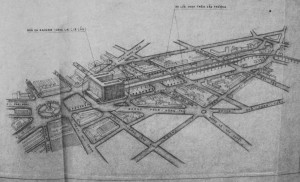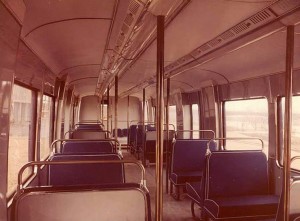
A suspended monorail car on SAFEGE’s test track at Châteauneuf-sur-Loire in the early 1960s
As plans to build an ambitious US$154 billion urban railway and monorail network in Hồ Chí Minh City slowly take shape, it’s worth remembering a scheme advanced nearly 50 years ago to build a monorail system in Saigon.
By the mid 1960s, attacks by the National Liberation Front (NLF) had devastated South Việt Nam’s railway infrastructure, leaving it with just 357km of operational rail track in three isolated sections south of the 17th parallel. As the US Army set to work building logistics bases and support facilities for its troops, the refurbishment of the railway network was prioritised, along with the improvement of airfields and expansion of port facilities. In June 1966, the US Military Assistance Command Việt Nam (MACV), USAID, the Saigon government and its Joint General Staff jointly devised the US$25 million “Railroad Sabotage Replacement Program” to restore the southern railway network to operational condition.

The Saigon elevated railway station scheme
Encouraged by this massive US investment in its rail infrastructure, the Ministry of Transport decided to chance its hand by submitting to its American sponsors a number of other related – but perhaps not quite so essential – transport infrastructure projects.
These included an extraordinary plan to raise the railway line as it entered Saigon Station (then located alongside Phạm Ngũ Lão street in District 1), channelling it into a brand new elevated terminus, complete with a 15-storey office, hotel and apartment block which would have towered over Bến Thành Market.
However, perhaps the most intriguing plan of all was that put forward in 1966 to build a state-of-the-art two-line monorail system connecting Phú Lâm, Chợ Lón, Saigon and Gia Định (Bình Thạnh).

Interior of a suspended monorail car designed by SAFEGE, 1960 (photo credit: University of Washington Libraries)
With traffic congestion in the city increasing by the day, it would appear as if the authorities already regretted their 1956 decision that trams would be “abolished permanently and replaced by buses” (see my earlier post on the Saigon Tramway Network). For documents unearthed in the National Archives show that in 1966 the South Vietnamese Ministry of Transport commissioned a proposal from French “suspended metro” specialists SAFEGE-Transport (Société Anonyme Française d’ Etude de Gestion et d’ Entreprises) for the construction of two monorail lines – with routes not greatly dissimilar to the electric tramway lines abolished so eagerly just a decade earlier!
Monorail Line 1 would have travelled 9.4km from Phú Lâm via Chợ Lớn to the Bến Thành Market on Diên Hồng (modern Quách Thị Trang) square. There, it would have connected with the 6.6km Monorail Line 2, which would have run along Hàm Nghi to the Sài Gòn waterfront, then northwest along Đại lộ Cường Để (đường Tôn Đức Thắng) to Hồng Thập Tự (đường Nguyễn Thị Minh Khai) and finally northeast to Đa Kao and Gia Định.
The whole scheme would have cost at least US$48 million to build and its implementation was entirely dependent on foreign financial assistance. However, it seems not to have impressed the Americans. Like the elevated station project, the 1966 Saigon Monorail scheme was eventually derailed due to lack of funding.
Tim Doling is the author of The Railways and Tramways of Việt Nam (White Lotus Press, Bangkok, 2012) and also gives talks on Việt Nam railway history to visiting groups.
Tim is also the author of the guidebook Exploring Saigon-Chợ Lớn – Vanishing heritage of Hồ Chí Minh City (Nhà Xuất Bản Thế Giới, Hà Nội, 2019)
A full index of all Tim’s blog articles since November 2013 is now available here.
Join the Facebook group Rail Thing – Railways and Tramways of Việt Nam for more information about Việt Nam’s railway and tramway history and all the latest news from Vietnam Railways.
You may also be interested in these articles on the railways and tramways of Việt Nam, Cambodia and Laos:
A Relic of the Steam Railway Age in Da Nang
By Tram to Hoi An
Date with the Wrecking Ball – Vietnam Railways Building
Dong Nai Forestry Tramway
Full Steam Ahead on Cambodia’s Toll Royal Railway
Goodbye to Steam at Thai Nguyen Steel Works
Ha Noi Tramway Network
How Vietnam’s Railways Looked in 1927
Indochina Railways in 1928
“It Seems that One Network is being Stripped to Re-equip Another” – The Controversial CFI Locomotive Exchange of 1935-1936
Phu Ninh Giang-Cam Giang Tramway
Saigon Tramway Network
Saigon’s Rubber Line
The Changing Faces of Sai Gon Railway Station, 1885-1983
The Langbian Cog Railway
The Long Bien Bridge – “A Misshapen but Essential Component of Ha Noi’s Heritage”
The Lost Railway Works of Truong Thi
The Mysterious Khon Island Portage Railway
The Railway which Became an Aerial Tramway
The Saigon-My Tho Railway Line

